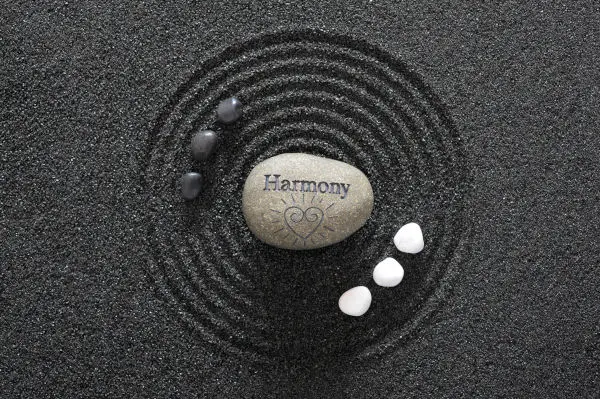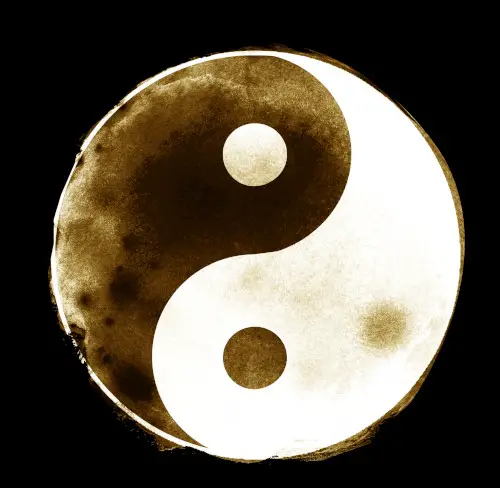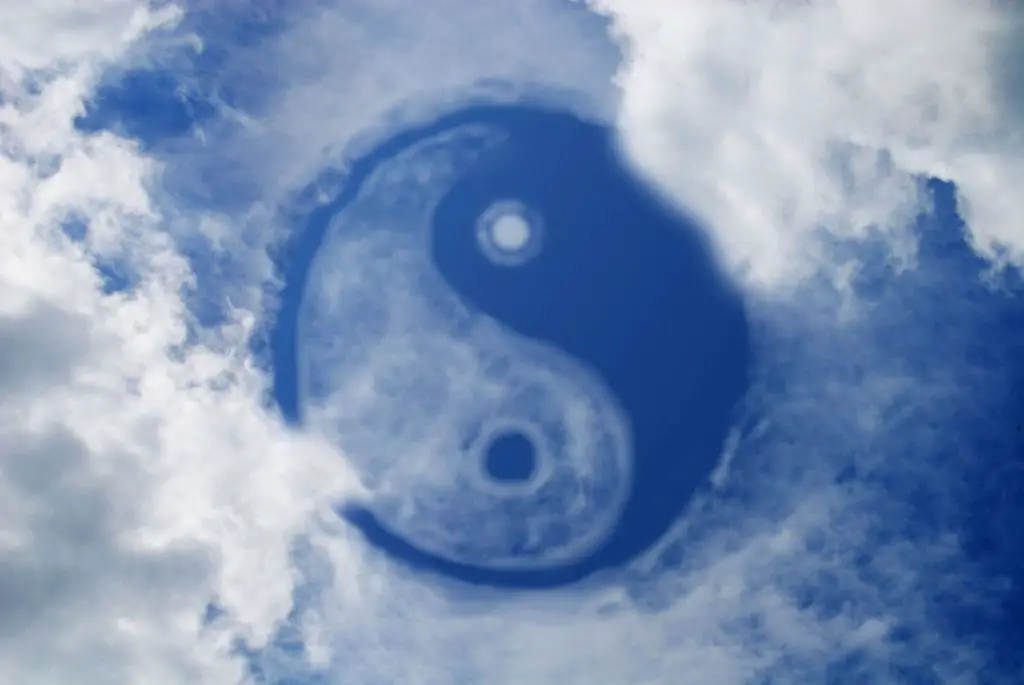The concept of yin and yang (陰陽) is often depicted as a circle divided into two swirling halves, black and white. But this iconic symbol holds a deeper meaning than simple opposites. Yin and yang aren’t about separation, but rather about a complementary dance.
Imagine the day and night cycle. Daytime, bright and energetic, embodies the yang aspect. Nighttime, with its quiet darkness, represents yin. Yet, each one relies on the other. Without night, we wouldn’t appreciate the brilliance of day.
This concept extends to all aspects of life. We experience periods of activity (yang) followed by times of rest (陰 – yin). We have moments of intense focus (陽 – yang) balanced by creative inspiration (yin). Yin and yang aren’t about striving for one over the other, but about finding the harmonious flow between them.
So, how can we harness this ancient wisdom to create a more balanced life? Let’s delve deeper and explore some practical applications of yin and yang in our daily routines.
Yin and Yang Principles
Yin and yang, rooted in ancient Chinese philosophy, embody the dualistic nature of existence.
Yin: The Receptive Embrace
Yin, often depicted as the black swirl within the symbol, embodies the receptive, feminine principle. It’s associated with darkness, stillness, coolness, and inward reflection. Think of yin as the fertile ground that silently nourishes life, the quiet contemplation that sparks creativity, or the restful sleep that rejuvenates the body.
Yang: The Active Force
Yang, represented by the white section, embodies the active, masculine principle. It’s associated with light, movement, warmth, and outward action. Imagine the sun’s rays energizing the earth, the focused concentration that fuels productivity, or the assertive expression that brings ideas to life.
Harmony Through Balance
Yin and yang aren’t isolated opposites, but rather interdependent forces in a constant dance. One cannot exist without the other. Just as the day cannot exist without night, or the seed cannot sprout without sunlight, both yin and yang are necessary for optimal vitality.
Think of a healthy life as a dynamic equilibrium. We need periods of focused activity (yang) balanced by restorative rest (yin). We crave moments of quiet reflection (yin) to spark creative ideas that propel us into action (yang). When these forces are out of balance, we might experience burnout from excessive yang activity or feel stagnant due to a lack of yin receptivity.
Application to Personal Life
The power of yin and yang lies in its practical application. By recognizing these principles in your daily life, you can cultivate a more balanced approach. Here are some ways to integrate yin and yang:
- Schedule active workouts (yang) followed by relaxing stretches (yin).
- Balance periods of intense study (yang) with contemplative walks in nature (yin).
- Practice assertive communication (yang) while remaining open to other perspectives (yin).
Remember, life is a continuous flow between yin and yang. By embracing both sides of the spectrum, you can cultivate a sense of harmony and well-being in your own personal journey.

Related reading: Exploring The Importance Of Family In Chinese Culture – Opens in new tab
Balancing Yin and Yang Energies
Now that we understand the principles of yin and yang, the question becomes: how can we achieve a harmonious balance between these forces in our own lives? The truth is, life rarely presents perfect equilibrium. However, by recognizing imbalances and incorporating practices that promote balance, we can cultivate a sense of inner peace and well-being.
Signs You’re Out of Balance: The Yin and Yang Imbalance Check-In
The first step to achieving balance is recognizing when your yin or yang energy is dominant. Here are some common signs:
- Yin Deficiency (Excessive Yang): Chronic stress, burnout, insomnia, restlessness, anxiety, hyperactivity, difficulty relaxing.
- Yang Deficiency (Excessive Yin): Excessive lethargy, fatigue, lack of motivation, procrastination, poor circulation, weakened immune system, feelings of isolation.
| Yin Deficiency (Excessive Yang) | Yang Deficiency (Excessive Yin) |
|---|---|
| Chronic stress | Excessive lethargy |
| Burnout | Fatigue |
| Insomnia | Lack of motivation |
| Restlessness | Procrastination |
| Anxiety | Poor circulation |
| Hyperactivity | Weakened immune system |
| Difficulty relaxing | Feelings of isolation |
Related reading: How Ancient Chinese Wisdom Holds the Keys to Modern Personal Growth– Opens in new tab
Restoring equilibrium
To restore harmony and balance between yin and yang energies, incorporating practical strategies and holistic practices can be immensely beneficial. Some of these practices are:
- Mindfulness Meditation and Breathwork: These practices cultivate a state of quiet receptivity (yin) while enhancing focus and clarity (yang).
- Acupuncture and Traditional Chinese Medicine: These holistic approaches utilize techniques like acupuncture to stimulate specific points on the body, promoting the flow of energy (qi) and restoring balance.
- Balanced Nutrition: Nourish your body with a balanced diet that includes both grounding yin foods (vegetables, whole grains) and energizing yang foods (lean proteins, healthy fats).
- Self-Care Rituals: Schedule time for both restorative activities (yin) like taking a warm bath or reading a book, and activities that spark joy and creativity (yang) like dancing or spending time in nature.
Beyond external practices, cultivating inner awareness and attunement to the subtle shifts of yin and yang energies within ourselves is paramount. By tuning into the rhythms of our body, mind, and spirit, we develop a deeper sense of self-regulation and resilience. This inner attunement allows us to navigate life’s challenges with grace and adaptability, aligning with the natural flow of existence.

Harmony in Relationships and Environment
The principles of yin and yang extend far beyond personal well-being. They offer valuable insights into fostering balance and harmony in our relationships with others and the environment we inhabit.
Yin and yang in relationships
The concepts of yin and yang provide valuable insights on cultivating positive relationship dynamics in the complex dance of human connections. Just as yin and yang complement each other in the natural world, successful relationships thrive on the foundation of mutual respect, balance of power, and recognition of complementary strengths.
Mutual respect forms the cornerstone of harmonious relationships, allowing individuals to honor each other’s unique perspectives and boundaries. Balancing power dynamics ensures that neither party dominates the relationship, fostering an environment of equality and cooperation.
Embracing complementary strengths allows individuals to support and uplift each other, creating synergy and harmony in partnerships, friendships, and familial connections.
Creating harmonious spaces
Applying the principles of yin and yang to our living environments can profoundly impact our well-being and sense of harmony.
In interior design, incorporating elements of both yin and yang—such as soft textures and soothing colors alongside vibrant accents and dynamic shapes—creates a balanced and inviting space. Feng Shui principles further enhance harmony by optimizing the flow of energy, or qi 气, within a space, promoting balance and tranquility.
Beyond aesthetics, fostering harmonious social dynamics and community cohesion within our living environments cultivates a sense of belonging and interconnectedness. By nurturing spaces that honor the interplay of yin and yang energies, we create environments that support our holistic well-being and foster a sense of harmony in our daily lives.
| Relationship Dynamic | Yin | Yang |
|---|---|---|
| Communication | Active listening, empathy | Clear and assertive expression |
| Power Balance | Supportive, nurturing | Taking initiative, leadership |
| Emotional Expression | Vulnerability, emotional intelligence | Confidence, setting boundaries |
Related reading: Chinese Symbol of Strength – Characters, Symbolic Animals and How to Use It in Feng Shui – Opens in new tab
Embracing Change and Transformation
Life, like the ever-turning symbol of yin and yang (陰陽), is a dynamic dance of change. Nothing remains constant forever. Seasons shift, day gives way to night, and moments of growth are inevitably followed by periods of rest. Understanding yin and yang can equip us to not only navigate these cycles of change but also embrace them as opportunities for transformation.
Flowing with cycles of change
Imagine life as a river. There are periods of calm, flowing water (陰 – yin) representing times of stability and routine. During these phases, we can focus on building our resources, nurturing relationships, and establishing a sense of security.
Yet, the river also encounters rapids and waterfalls (陽 – yang) symbolizing periods of challenge, transition, and upheaval. These periods of change may feel unsettling, disrupting our comfort zones and demanding our adaptability.
However, they are also opportunities for growth and renewal. Just as the rapids carve new pathways in the riverbed, challenging experiences can lead us to discover new strengths, develop new skills, and ultimately emerge from the experience transformed.
The key is to approach change with an open mind and a willingness to surrender to the flow. By trusting that change is a natural part of life’s journey, we can navigate these periods with greater ease, cultivating the resilience necessary to ride the waves of change and emerge stronger on the other side.
Transformation and growth
Embracing both yin and yang aspects of experience holds transformative potential, guiding individuals on a journey of personal growth and self-discovery. Just as yin nurtures seeds of potential in the darkness of soil, yang propels them towards the light of realization.
Through periods of challenge, transition, and self-discovery, embracing these dual forces fosters adaptation and evolution. By integrating introspection and action, receptivity and assertiveness, individuals harness the power of balance to navigate life’s twists and turns with courage and grace.
In this dance of yin and yang, transformation becomes not only a destination but also a continual process of unfolding and becoming.
| Stage of Transformation | Yin Aspect | Yang Aspect |
|---|---|---|
| Growth | Nurturing seeds of potential | Propelling towards realization |
| Decay | Allowing for release and letting go | Clearing space for new beginnings |
| Renewal | Embracing new possibilities | Taking decisive action for transformation |
End Words
In conclusion, the ancient wisdom of yin and yang offers a profound framework for navigating the complexities of life. By embracing the dance between seemingly opposite forces, we can cultivate balance within ourselves, foster harmony in our relationships and environments, and approach change with a sense of acceptance and growth.
The journey towards a balanced life is an ongoing exploration, but with the principles of yin and yang as our guide, we can move through life’s experiences with greater resilience, adaptability, and a deep sense of connection to the ever-flowing rhythm of the universe.
Related reading: The Importance of “Guanxi” 关系 (Relationships) in Chinese Society – Opens in new tab
Stay in Touch
 Join our newsletter by using the forms on this website or click here!
Join our newsletter by using the forms on this website or click here! Follow us on Google News
Follow us on Google News Follow us on Facebook
Follow us on Facebook
Feature Image from Depositphotos





